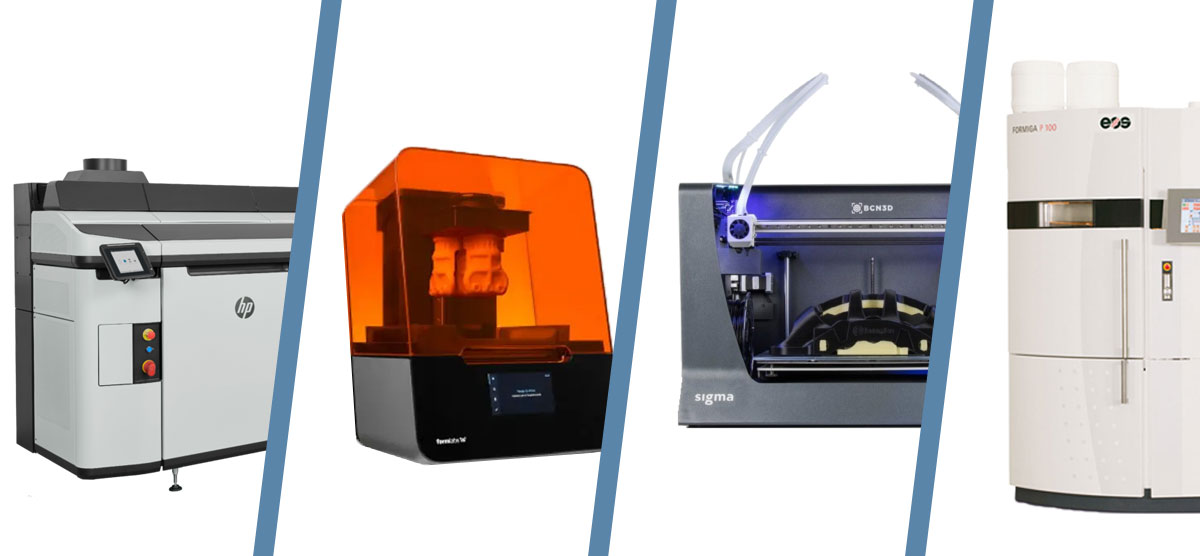
3D Printing Technology Comparison
The choice of 3D printing technology to print a prototype, trial version, or any object will depend on what is expected from the object. Each technology has its own set of strengths and weaknesses and will define the properties of the printed object. In this article, we will take a closer look at the four most used types of 3D printing technologies: Fused Deposition Modeling (FDM), Stereolithography (SLA), Selective Laser Sintering (SLS) and Multi Jet Fusion (MJF).
Fused Deposition Modeling (FDM)
Fused deposition modeling (FDM) is a 3D printing technology based on extrusion. The building materials used in FDM are thermoplastic polymers and come in fiber form. In FDM, a part is manufactured by selectively depositing molten material layer by layer in a path defined by a CAD model. Due to its high precision, low cost and large selection of materials, FDM is one of the most widely used 3D printing technologies worldwide.
Materials for FDM printing technology
The most common rigid plastics used by nexus3dhub include:
PLA, ABS, PETG, ASA, TPU, Nylon, PC, PA CF /polyamide with carbon admixture/, PEEK, PEEK CF
Stereolithography (SLA)
Stereolithography was one of the first additive manufacturing technologies that was theorized and patented in the 1980s. The concept behind it, although there are many variations today, is fairly simple: a near-UV laser beam is focused and quickly draws a 2D cross-section of an object onto a thin layer of liquid photopolymer resin. The photosensitive resin polymer then reacts and hardens to form a single 2D layer of the object. Depending on whether the laser is coming from below or above, the object is raised one depth while still in contact with the resin, or a new layer of resin is applied to the object. Then the process is repeated for each new layer of the object until the 3D printed object is complete. The last step is to clean the finished resin-soaked object and remove any supporting structures.
Materials for SLA printing technology
The most commonly used photopolymer resins used by nexus3dhub include:
ABS like resin, Clear resin, Tough resin, High temp resin
Selective Laser Sintering (SLS)
The SLS 3D printer uses a laser as an energy source, which selectively melts powdered plastic material and combines it into a complex object. This technology is part of Laser Powder Bed Fusion (LPBF), one of the most advanced and reliable technologies in the field of additive manufacturing 3D printing.
Using 3D data from the CAD model, the laser melts the plastic material precisely at pre-determined locations in the powder bed. After the melting process is complete, the build platform is lowered and a new layer of powder is added. This process is repeated layer by layer until the piece is complete.
Selective laser sintering is very popular in the field of plastic 3D printing due to its substantial advantages, such as design freedom, high productivity and low part cost. Unlike some other 3D printing technologies, such as SLA or FDM, SLS technology does not require any support structures. This allows the creation of very complex patterns.
Materials for SLS printing technology
The most common materials used by nexus3dhub include:
PA12, PA11, PA12 GB
Multi Jet Fusion (MJF)
The Multi Jet Fusion 3D printing process consists of the following steps. The printer head deposits a thin layer of powder material on the base. The ink head moves over the layer of powder and applies two different types of liquid agents to it: fixing and detailing. The heating unit moves through the powder bed. Wherever the fixative has been added, the layer underneath will melt and form the shape, while the areas with the detailing agent will remain as loose powder without melting. A detailing agent is used to define the exact boundaries of a part for dimensional accuracy. The powder is cleaned, leaving the printed part with the desired geometry. This loose powder eliminates the need for supporting structures, as the lower layers support those printed above them (similar to SLS technologies). To complete the printing process, the entire powder bed and printed parts within it are moved to a separate processing station. Here, most of the released unmelted powder is vacuumed, allowing it to be reused instead of creating excess waste.
Multi Jet Fusion (MJF) is one of the most commonly used 3D printing technologies that are highly accurate and durable. Compared to SLS technology, MJF prints are more cost-effective at scale. Parts printed with MJF are widely used for prototypes as well as final parts.
Materials for MJF printing technology
The most common materials used by nexus3dhub include:
PA12, PA11, PA12 GB, PP
Source: HP, EOS, BCN3D, Formlabs
